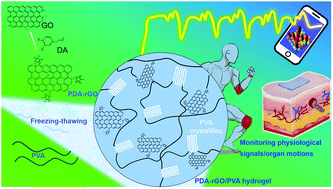Biomimetic epidermal sensors assembled from polydopamine-modified reduced graphene oxide/polyvinyl alcohol hydrogels for the real-time monitoring of human motions†
Abstract
Conductive hydrogel-based epidermal strain sensors can generate repeatable electrical changes upon mechanical deformations for indication of the skin's physiological condition. However, this remains challenging for many conductive hydrogel sensors due to biomechanical mismatch with skin tissues and an unstable resistance variation response, resulting in non-conformable deformations with the epidermis and dermis, and consequently generating inaccurate monitoring of human movements. Herein, a conductive hydrogel that highly matches the skin is fabricated from dynamically hydrogen-bonded nanocrystallites of polydopamine-modified reduced graphene oxide (PDA–rGO) nanosheets composited with polyvinyl alcohol, namely the PDA–rGO/PVA hydrogel. PDA–rGO provides a large number of dynamic hydrogen-bonding interactions in the hydrogel, resulting in a skin-matching modulus (78 kPa) and stretchability. Moreover, the resultant hydrogel possesses excellent cytocompatibility and conductivity (0.87 S m−1), high sensitivity (gauge factor of compression: 20) at low strain and outstanding linearity at high strain as well as a stable resistance variation response. These desirable properties enable the application of the PDA–rGO/PVA hydrogel as a skin-friendly wearable sensor for real-time and accurate detection of both large-scale joint movements and tiny physiological signals, including the bending and relaxing of fingers, the wrist, elbow and knee joints, and wrist pulse and swallowing. Moreover, this hydrogel is integrated into a 2D sensor array that monitors strains or pressures in two dimensions, which is promising for electronic skin, biosensors, human–machine interfaces, and wearable electronic devices.

- This article is part of the themed collections: 2020 Journal of Materials Chemistry B most popular articles and Journal of Materials Chemistry B Lunar New Year collection 2021


 Please wait while we load your content...
Please wait while we load your content...